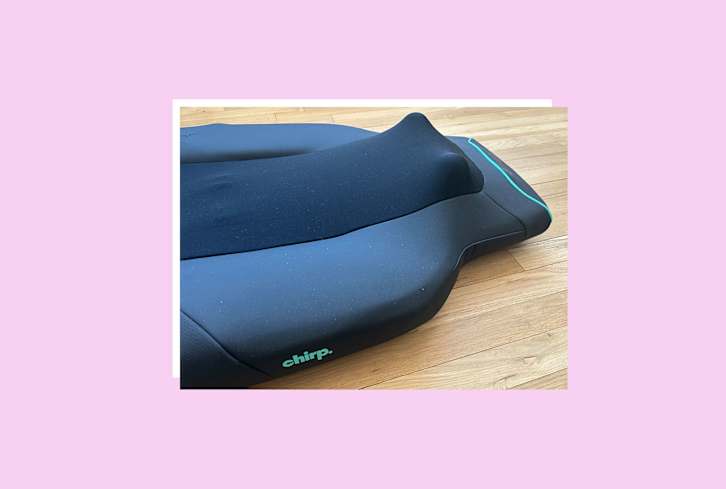Advertisement
I Experienced Extreme Burnout & Anxiety Symptoms — Until I Made These Changes


From a young age I was always known as the little girl who had it all together. I grew up in a fairly unstable environment—my bohemian mother and I lived on a boat and I changed schools 12 times before high school. The instability of my home life contributed to a need to find structure and a way to gain control over what little I could.
I soon became a chronic overachiever, leaning into academics and accomplishments as a structure for finding praise and security. From the outside this looked like ambition, intelligence, and drive but underneath it all I had a constant pit in my stomach. I was riddled with stress, anxiety and depression.
It was the early aughts and no one was talking about mental health, especially to high school and middle schoolers. I remember having the thought at the age of 12 that if I told my counselor at school how depressed and anxious I was, I might be taken to a “crazy farm”—probably something I had heard in a movie.
While these machinations of a 12-year-old brain sound ridiculous, I really was terrified of the stigma around depression and anxiety, so I bottled it up and just kept going without any support and without anyone knowing what I was going through. It wasn't until I became an adult that my body began to quite literally break down under the bottled up stress I had been putting it through since childhood.
My health took a dramatic turn in grad school
During graduate school, I started having to admit myself to the hospital on a regular basis. I was experiencing bleeding in my gut, along with extremely painful inflammation in my stomach and colon. Basically my entire digestive system would go into a full meltdown, requiring me to be hospitalized and on morphine—sometimes for two weeks at a time.
Every time I went in, the doctors would try to find something to solve with pills and surgery. They would check me for things like appendicitis, e-coli and salmonella, ulcers. But they would never find anything. Colonoscopies and endoscopies would reveal something that looked like Chrones or colitis, but my other symptoms didn't align with those diagnosis. I was always left with the single option of living on steroids to control inflammation.
After I graduated, I began a rigorous job working for a famed architect that required me to work 90-hour weeks, and I hardly went home. Needless to say, my body didn't handle that well. Every few months, I'd end up hospitalized for weeks on end.
After being in the hospital with a particularly bad flare-up, the doctors were discussing possible transfusions. In that moment, I knew I had to change something—my body needed me to figure this out once and for all.
How I began my healing journey
Due to some work visa timing, I was forced to take a break from my job. At first this looked unlucky, I would have to take time off and I was in the middle of an exciting project. But it ended up being a well-timed opportunity to help my body recover. Being forced to take that break changed my life for the better.
At the time, the wellness industry was fairly nascent and hard to navigate. People barely knew what the words “holistic” and “integrative” meant when it came to health. It proved difficult to find a path forward. I’d been getting into yoga at the time, so my first step was I to take a deeper dive into the practice through training to be a teacher. I began learning how to teach meditation, and increased my own meditative practices.
I was very intrigued by more preventative approaches to medicine, so I started to cultivate a community of holistic practitioners. I used word of mouth in the yoga community to find a a holistic nutritionist to guide me through an elimination diet, to see if any foods might be triggering my symptoms. With her help, I cut out all sorts of inflammatory foods over a strict six month period.
While I couldn’t live on such a strict diet forever, and my boyfriend and friends would definitely break up with me if I did, I can say that going on that diet helped reset my body in a way that was similar to being on steroids after a hospital visit. In other words, I felt really good and there were no flare-ups in sight. Learning how to follow an anti-inflammatory diet helped me recalibrate my body for the long run without the need of constant pharmaceuticals.
But I knew this was about more than my body. During this time I began to understand that if I wanted to heal my body, I needed to address emotional health issues that I had been dealing with for a long time. Most importantly, - I needed to get my stress levels under control. I learned the chronically high cortisol levels that I had been experiencing had been one of the main culprits of my inflammatory response.
I started to explore more practices to help calm down my nervous system and process unaddressed trauma. I found a lot of help in hypnotherapy and have had a great experience with EMDR (Eye Movement Desensitization and Reprocessing (EMDR). By prioritizing practices that supported me mentally, I started to see improvement with my confusing invisible illness.
After my experience, I wanted to help others find support
Through my healing journey, I met so many other people who were experiencing health challenges, who were also interested in working with holistic professionals. However, they didn't really know how or get in touch with them, or determine the right practitioner to seek out for their specific issue. That's where the idea for my company WellSet first emerged.
I started WellSet in 2017 with my co-founder Sky Meltzer. We started out as a marketplace to find and book wellness providers, who had been curated and vetted. However, in the years that followed, we discovered most of the people coming to our platform could only afford one session with one of these experts—so we set out to help increase care and make it more accessible overall.
Now, we have a subscription model that offers livestreamed classes, an on-demand class library, and an article portal—to provide affordable resources to as many people as possible. We're also continuing to seek out even more ways we can increase access through various partnerships with insurance companies, schools, companies, and more.
I don't have all the answers, but I'm proud of my progress
I still don't have an official diagnosis because what I've experienced doesn't fit into one box. Occasionally, I still have flare-ups (yearly or once every few years), without a lot of rhyme or reason. However, now, they aren't nearly as severe, and I don't have to spend weeks in the hospital. In fact, I haven't had a major flare-up in over five years. I attribute this progress to a combination of things: adequate sleep, a healthy diet, managing stress levels, moving my body in a gentle way, prioritizing recovery, and going to therapy.
Through my own research and journey to recovery, I've come to the theory that all of my unaddressed traumas and stress from my earlier years led to chronic inflammation. Even though I didn't realize it at the time, I think by internalizing all my fears and anxieties, it finally took a toll on my physical body, too.
That's why, I strongly believe—whether you have a simple cold or a more serious condition—your mind-body connection is essential to healing. So even if you're recovering from a very physical ailment, taking care of your mental and emotional well-being throughout the journey is just as crucial.


















